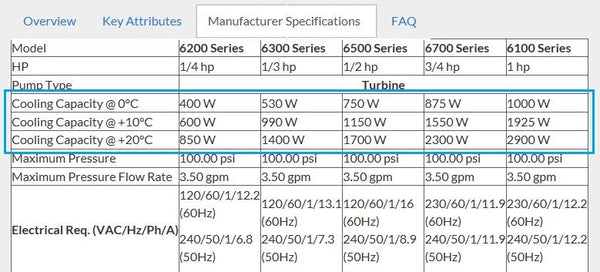When you rely on a piece of equipment to do its job, it can be frustrating to find that issues are causing it to become inefficient for its application. If a chiller cannot reach its setpoint temperature, it will give a high temperature warning and stop chilling.
In this post, we take a look at several possible reasons your chiller isn’t holding temperature and what you can do about it.
1. The Chiller Isn’t Powerful Enough
This is an obvious reason and probably one you don’t want to hear. But if your chiller isn’t holding temperature, it could simply be due to it being incapable of the power output needed to maintain the temperature you’ve set. If the heat load is more than the chiller is able to remove, then it won't be able to hold temperature. If this is the issue, shopping for an upgrade might be your best option.
Another consideration is ambient heat gain. An additional heat load may be added to the system as the cold coolant runs through tubes or pipes. If this is the issue, it can potentially be solved with insulation.
2. The Temperature Is Set Too Low
Before you start browsing new equipment, it’s worth considering if perhaps the setpoint temperature of your machine is too low for it to hold. For all chillers, the cooling capacity of the machine decreases as the temperature decreases. The manufacturer specifications for a chiller will tell you the cooling capacity at a particular temperature, usually at 20°C.
Manufacturer specifications for some of the 6000 Series Portable Chillers.
When you have a setpoint lower than that temperature, you can expect the cooling capacity to drop. As such, to achieve a higher cooling capacity, you’ll need to increase the setpoint temperature.
3. You’ve Been Skipping On Maintenance
Like every piece of lab equipment, chillers need to be well-maintained to ensure they keep running efficiently.
Failure to keep up with maintenance could result in a variety of issues. For air-cooled condensers, dust and debris buildup on fins and fan blades can inhibit air flow, lowering the cooling capacity. For water-cooled condensers, heat transfer can be reduced by scale formation, biological growth, or corrosion.
Some regular maintenance that needs to be performed -- depending on the type of equipment -- might include cleaning the condenser fins, flushing the coolant, and using a corrosion inhibitor.
4. The Heat Transfer Fluid Has Low Thermal Conductivity
The cooling capacity of a chiller is often based on using water or ethanol as the heat transfer fluid. Water is ideal since it has high heat capacity and thermal conductivity, but alone it can cause corrosion. Ethanol is a good circulator since it remains fluid at low temperatures but it is also highly flammable. In many cases the chosen fluid will be a mixture of water with ethylene glycol or propylene glycol, which provide freeze and corrosion protection, as well as bactericidal properties.
The thermal conductivity of these solutions is not as high as that of water, and with higher levels of glycol, you’ll see a decrease in thermal performance. In order to reap the benefits of using a glycol solution while having minimal impact on the efficiency of the chiller, it’s recommended to keep the glycol level as low as possible. According to Lytron, 30% ethylene glycol will provide the required protection and result in a decrease in thermal performance of around 3%.
5. The Ambient Air or Facility Water Temperature Is High
Depending on whether it’s air-cooled or water-cooled, the chiller condenser needs to transfer heat to the ambient air or facility water. When the temperature of these is higher, the heat transfer is less efficient. This causes a higher condensing pressure and a reduction in overall system performance. A lower ambient air or facility water temperature can boost the efficiency of the chiller and help it hold temperature.
As you can see, there are various factors that may be contributing to your chiller not holding temperature. Some require fairly simple and inexpensive fixes so it's worth exploring all potential issues before rushing out to buy a new machine.

